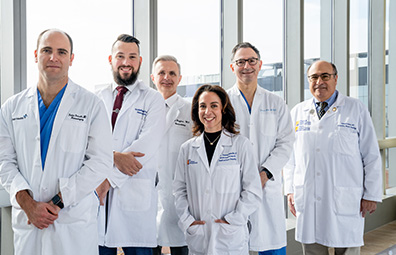Oligodendrogliomas and Oligoastrocytomas (Mixed Gliomas)
Oligodendrogliomas and oligoastrocytomas originate from the supportive tissue of the brain (glial cells). Oligodendrogliomas are named after oligodendrocytes, cells in the brain and spinal cord that insulate and protect nerve cell fibers. Oligoastrocytomas (mixed gliomas) contain a combination of cell types found in two types of glioma tumors – oligodendromas and astrocytomas. These tumors are often associated with seizures and found in young and middle-aged adults. They are typically slower-growing, low-grade tumors with a good chance of successful treatment.

Meet Our Brain Tumor Care Team
Meet the specialists at the Gerald J. Glasser Brain Tumor Center who are experts in treating oligodendrogliomas and oligoastrocytomas.
Meet the TeamSymptoms
Some oligodendrogliomas and mixed gliomas reach a fairly large size before they cause noticeable symptoms, which can include:
- Seizures
- Headaches
- Nausea
- Memory loss
- Vision loss
- Language difficulties
- Changes in personality
- Cognitive impairments
- Weakness or numbness in the arms or legs
Diagnosis
Oligodendrogliomas and oligoastrocytomas are diagnosed through a neurological examination followed by a computed tomography (CT) or magnetic resonance imaging (MRI) scan of the brain. MRI scans are usually performed with contrast dye to help identify the tumor’s size, location and type.
An exact diagnosis can only be confirmed following a stereotactic biopsy or surgical removal of the tumor. Tissue analysis by a neuropathologist defines the diagnosis and genetic profile of the tumor.
Treatment
Surgery to remove the tumor is typically the initial treatment. We use the latest techniques to make craniotomy (surgical opening of the skull) as safe and effective as possible. Techniques include:
- Stereotactic volumetric techniques help the surgeon achieve a near-total removal of the tumor.
- Depending on the location of the tumor, the neurosurgeon may employ advanced techniques to safely remove a tumor even in the parts of the brain that handle speech, vision and movement:
Alternatively, laser interstitial thermal therapy (LITT) may be used as a minimally invasive surgical alternative to open craniotomy. Or, a biopsy could be performed in patients with medical conditions that don't allow for surgery – or when there are concerns about the location of the tumor.
Some low-grade oligodendrogliomas and oligoastrocytomas that were removed can be closely observed through a series of follow-up MRI scans. Higher-grade tumors and those that were partially removed during surgery may require follow-up radiation, chemotherapy or both.
Our team will complete a diagnosis and molecular profile of each tumor, which is individually reviewed by our multidisciplinary tumor board. Together, our experts recommend the best personalized and targeted treatment options. They consider the exact tumor type and grade, how much of it was removed during surgery and insights from our genetic and molecular analysis. Treatments could include:
Our team will closely monitor you and personalize your follow-up care. Our patient navigator will also connect you with our support group and other resources.